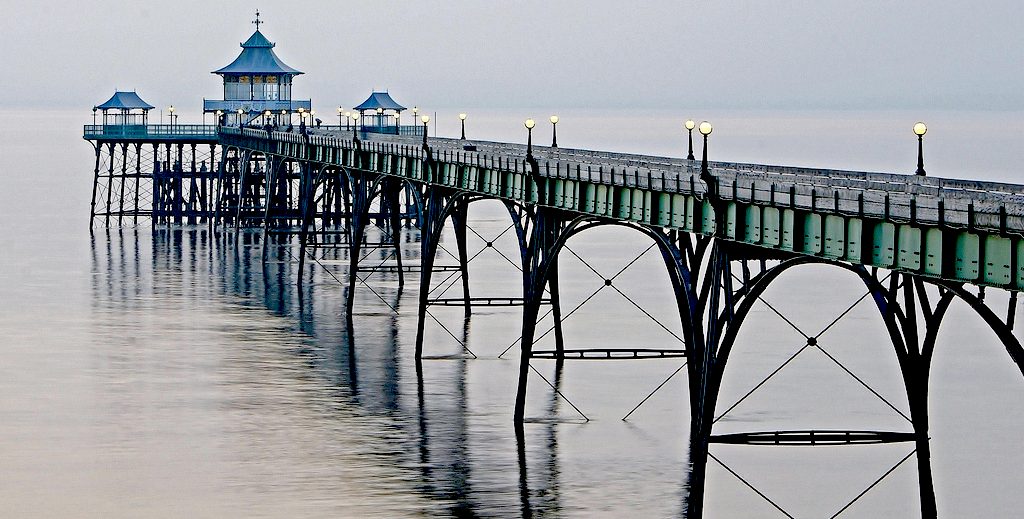|
CLEVEDON
PIER

CLEVEDON
PIER - This is one pier that was not designed by Eugenius
Birch, but he was an inspiration to other designers - and in
this case simplicity gave an elegance to a pier that even
Eugenius would have admired.
During the Victorian era, Clevedon became a popular seaside town, having previously been an agricultural village. Due to improving transport links, via the Clevedon Branch Line, Clevedon was able to cater for the late 19th century craze for bathing in the sea with saltwater baths adjacent to the pier (since demolished, though the foundations can still be seen), and bathing machines on the main beach. Many English seaside resorts built piers in the 1850s to attract tourists. At Clevedon tourism grew following the opening of a branch line from Yatton railway station which connected it to the Bristol to Exeter Line, enabling travel from the rest of the country. It was also proposed that a pier could form part of a route from London to South Wales with the use of steamers to cross the Severn Estuary. An enabling act was submitted to parliament in 1864.
On 16 October 1970, spans 7 and 8 of the pier collapsed during stress testing, which had been introduced in the 1950s as a requirement for obtaining insurance cover. The tests involved the placement of polythene tanks 50 ft (15.2 m) long, 5 ft (1.5 m) wide and 2 ft (0.6 m) deep filled to a depth of 10 in (25.4 cm), which created a pressure of 50 psf (2 kPa). This simulated the required load agreed with the Ministry of Transport.
Six tanks were used for each span and left in place for three hours; the 18 tanks used in total allowed three spans to be tested simultaneously. At the end of the three hours the tanks were emptied and dragged along the deck to test further spans. The first six spans passed without problems, but under load the seventh span collapsed, bringing down the eighth and final span, leaving the pier head and pavilion standing.
The Clevedon Pier Preservation Society was formed in 1972 and started campaigning for the restoration of the pier. The district council applied for permission to demolish the pier in 1979, but a public enquiry the following year ruled that it should be retained. The pavilions from the end of the pier were taken ashore in 1982 for storage in anticipation of eventual restoration; insufficient funds were available to complete restoration and the first stage was to open the Toll House as an exhibition centre in 1984.
A major breakthrough came in 1984, when English Heritage and the National Heritage Memorial Fund granted a million pounds towards the restoration, with smaller sums from Woodspring District Council and other funding bodies. The trust, which had been formed by the preservation society, also obtained a 99-year lease. The pier was dismantled in 1985, taken to Portishead dock for restoration, and reconstructed in 1986.
After a long campaign by local people to raise funds for restoration (supported by Sir John Betjeman, who described Clevedon as "the most beautiful pier in England"), the pier eventually reopened. Some funds were raised by "sponsored planks" – small brass plaques with names or messages are inlaid on the wooden planks and benches, recording donations. Reconstruction of the pier spans and decking was completed on 27 May 1989, and the pier was reopened to great enthusiasm. The pierhead was still shut, however, and it was not until 23 May 1998 that it was finally restored and opened to the public, as a result of funding from the Heritage Lottery Fund. In 1999 the National Piers Society awarded Clevedon Pier the title of Pier of the Year, and it also won a Civic Trust Award. The pier was re-designated a Grade 1 listed building in 2001, the only other pier with this status being Brighton's West Pier (largely destroyed by fire and storms between 2002 and 2004).
The landing stage at the end of the pier is used throughout the summer season (June to September) by the Waverley and her sister ship, the Balmoral, and is a popular spot for angling. There is a cafe at the pierhead, and a souvenir shop at the toll house. The upper floor of the toll house is an art gallery with a different exhibition every month. The pier is open every day of the year except Christmas Day. Scenes from the 2010 film, Never Let Me Go, starring Keira Knightley were filmed near Clevedon pier during 2009, and the pier also featured on the promotional posters. One Direction's music video for their single "You & I" was filmed on Clevedon Pier. An appeal was launched in 2012 to raise £1.6 million for a new visitor centre and educational facility, an additional £800,000 of grants have been applied for to cover the cost of repainting the legs of the structure. In December 2012 it was announced that the pier had received £720,000 of funding from the Heritage Lottery Fund to improve the visitor centre.
PIER
HISTORY
.......

LINKS
& REFERENCE
Risk
Historic England register 46600 pier Hastings
Telegraph
UK news 200 years of historic British piers in pictures
http://brightonpier.co.uk/
Express
UK News seaside-piers-still-giving-us-pleasure-200-years-later
South
Parade Ttrust
BBC
UK news Southsea pier auction Hampshire
Southsea
Pier.com
Southsea
pier save the pier petition comment 8848
You
38 degrees petitions order repair of south parade pier
Wikipedia
South_Parade_Pier
Daily
Mail South Parade Pier Southsea sold auction guide price just
£200-000
https://en.wikipedia.org/wiki/South_Parade_Pier
https://you.38degrees.org.uk/petitions/order-repair-of-south-parade-pier
http://www.southseapier.com/2014/06/save-the-pier-petition/#comment-8848
http://www.southparadetrust.org/
http://www.bbc.co.uk/news/uk-england-hampshire-20683752
http://www.southseapier.com/
http://www.express.co.uk/news/uk/490774/Seaside-piers-still-giving-us-pleasure-200-years-later
|

